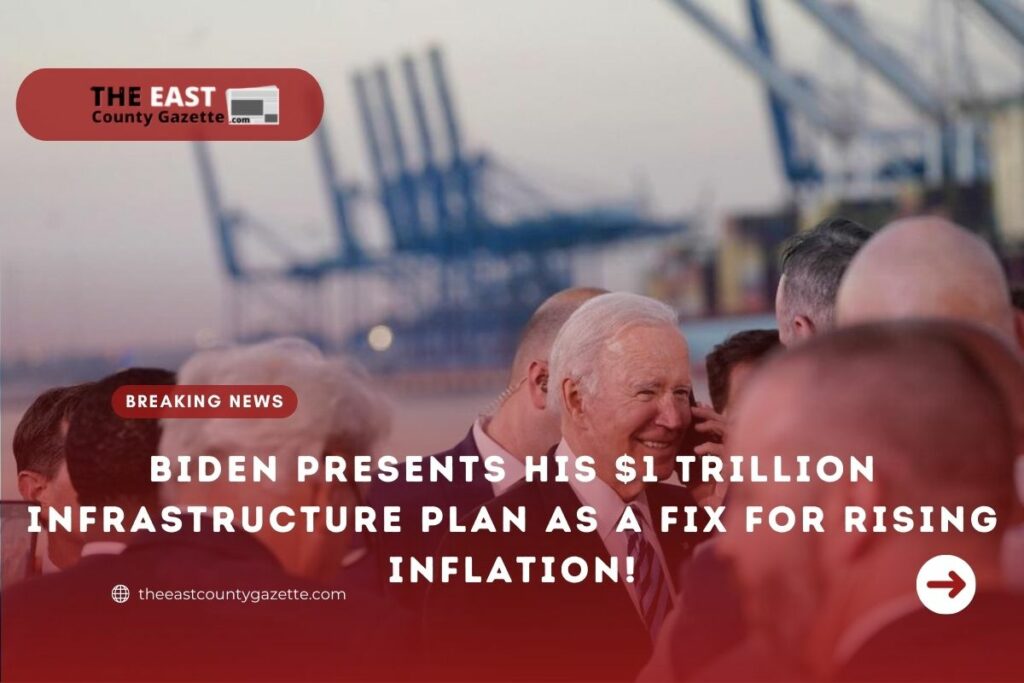As a potential fix to the nation’s inflation and supply chain problems, President Biden praised his $1 trillion infrastructure plan on Wednesday.
As part of his signature legislation, which cleared Congress last week and will be signed on Monday, the president toured the Port of Baltimore.
As a result of this investment, he stated, products and supplies from overseas and within the United States will travel more efficiently.
This, according to the first citizen of the United States, will lead to lower prices, fewer shortages, and more union jobs.
With consumer prices rising 6.2% year over year in October, the government’s action is becoming more urgent.
Since the economy reopened following the Coronavirus pandemic, inflation has intensified instead of fading.
Read More: Joe Biden Unveils Multibillion-dollar Plan To Upgrade Aging U.S. Ports
Later, the administration of Biden made the claim that the price hikes were temporary.
He acknowledged that consumer prices have remained excessive during his remarks at the port.
“Everything from a gallon of gas to a loaf of bread costs more,” he said.
“We still face challenges and we have to tackle them … we have to tackle them head-on.”
Biden’s popularity in polls has been negatively affected by these high prices, which have eaten into wages.
Backlogged ports at major transit hubs have been a significant obstacle to reducing inflation.
The result has been shortages and a lack of inventory in some stores ahead of the holiday shopping season.
“Many people remain unsettled about the economy and we all know why,” Biden said.
The solution proposed by Biden is his infrastructure plan, although it will take time to realize.
This solution can create a better infrastructure that would increase the supply chain’s capacity and resilience.
More capacity would allow ships to be unloaded and goods to be moved, reducing price pressures and shortages.
Biden said $45 per hour jobs would be created from infrastructure spending.
That is more than 50% higher than the national average.
Fixing aging pipes, bridges, roads, and pushing clean energy and cybersecurity will create a wealth of new jobs under the Infrastructure Plan.
Many such jobs will not require college degrees.
“This is a once in a generation investment,” he announced.
The president cited Baltimore’s port as a model for reducing shipping bottlenecks that slowed the economic recovery.
In addition, ship unloading will be possible on a 50-foot berth with container cranes that will be provided by the infrastructure plan.
Another benefit from grants is Baltimore’s port, which has received funding to upgrade the 1895-built Howard Street Tunnel.
As a result of the tunnel expansion, shipping containers can be stacked twice on railcars, facilitating a swift transport of goods from the port.
Walmart, Target, FedEx, UPS, and other CEOs participated in a meeting with the president on Tuesday, in which he emphasized that such investments are part of a nationwide effort to loosen up supply chain bottlenecks to foster larger economic growth.
Georgia’s port of Savannah is also in line for new investments from the Biden administration.
Read More: California Leaders: How Biden’s Infrastructure Bill Impacts the State
The move follows the administration’s role in brokering a deal that enabled the Port of Los Angeles to operate nonstop nearly a month ago.
His administration has attempted to explain that the port congestion demonstrates the strength of the economic recovery after the pandemic.
It is predicted that imports will reach record levels this year by the National Retail Federation.
Though, Inflation has become a global phenomenon as well, with high levels reported recently in China and Germany.
In a city of nearly 600,000, the president made his case to his supporters on Wednesday.
In last year’s election, nearly 90% of Baltimore voters supported Biden.
Television shows such as HBO’s “The Wire” have given Americans a glimpse into the city’s poverty, death, crime, and corruption.
Freddie Gray’s death from injuries in a police van in 2015 was a catalyst in launching a national movement for respect for the lives and rights of Black Americans.
Nevertheless, Baltimore also contains areas of wealth and prosperity, which can be seen as a microcosm of the wider inequalities facing the United States.

